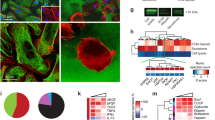Abstract
Platelet endothelial cell adhesion molecule (PECAM-1/CD31), a member of the immunoglobulin superfamily expressed at high levels on endothelial cells, has been recently implicated in angiogenesis. Although antagonism of PECAM-1 inhibited neovascularization in two different animal models of growth factor/chemokine-induced angiogenesis, its participation in tumor angiogenesis has not been established. We therefore investigated its involvement in models of tumor angiogenesis in mice. An antibody against murine PECAM-1 that was shown to block in vitro murine endothelial tube formation inhibited the subcutaneous growth and tumor vascularity of three tumors in mice: A549 human non-small cell lung cancer in SCID mice, B16 murine melanoma in C57BL/6 mice and AB12 murine mesothelioma in Balb/c mice. These studies suggest a possible role for PECAM-1 in the complex process of tumor angiogenesis and provide additional evidence of the importance of endothelial cell adhesion molecules to the formation of new vessels.
Similar content being viewed by others
References
DeLisser HM, Baldwin HS, Albelda SM. Platelet endothelial cell adhesion molecule 1 (PECAM-1/CD31): A multifunctional vascular cell adhesion molecule. Trends Cardiovasc Med 1997; 7: 203–10.
Newman PJ. The biology of PECAM-1. J Clin Invest 1997; 99: 3–8.
Lu TL, Barreuther M, Davis S, Madri JA. Platelet endothelial cell adhesion molecule-1 is hosphorylatable by c-Src, binds Src-Src homology 2 domain, and exhibits immunoreceptor tyrosine-based activation motif-like properties. J Biol Chem 1997; 272: 14442–6.
Jackson DE, Kupcho KR, Newman PJ. Characterization of phosphotyrosine binding motifs in the cytoplasmic domain of platelet/endothelial cell adhesion molecule-1 (PECAM-1) that are required for the cellular association and activation of the protein-tyrosine phosphatase, SHP-2. J Biol Chem 1997; 272: 24868–75.
Famiglietti J, Sun J, DeLisser HM, Albelda SM. Tyrosine residue in exon 14 of the cytoplasmic domain of platelet endothelial cell adhesion molecule-1 (PECAM-1/CD31) regulates ligand binding specificity. J Cell Biol 1997; 138: 1425–35.
DeLisser HM, Christofidou-Solomidou M, Strieter RM et al. Involvement of endothelial PECAM-1/D31 in angiogenesis Am J Pathol 1997; 151: 671–677.
Matsumura T, Wolff K, Petzelbauer P. Endothelial cell tube formation depends on cadherin 5 and CD31 interactions with filamentous actin. J Immunol 1997; 158: 3408–16.
Hanahan D, Folkman J. Patterns and emerging mechanisms of the angiogenic switch during tumorigenesis. Cell 1996; 86: 53–364.
Vecchi A, Garlanda C, Lampugnani M et al. Monoclonal antibodies specific for endothelial cells of mouse blood vessels. Their application in the identification of adult and embryonic endothelium. Eur J Cell Biol 1994; 63: 247–54.
Christofidou-Solomidou M, Nakada MT, Williams J et al. Neutrophil platelet endothelial cell adhesion molecule-1 participates in neutrophil recruitment at inflammatory sites and is down-regulated after leukocyte extravasation. J Immunol 1997; 158: 4872–8.
Doerschuk CM, Quinlan WM, Doyle NA et al. The role of P-selectin and ICAM-1 in acute lung injury as determined using blocking antibodies and mutant mice. J Immunol 1996; 157: 4609–14.
Kumasaka T, Quinlan WM, Doyle NA et al. Role of intercellular adhesion molecule-1 (ICAM-1) in endotoxin-induced pneumonia evaluated using ICAM-1 anti-sense oligonucleotides, anti-ICAM-1 monoclonal antibodies and ICAM-1 mutant mice. J Clin Invest 1996; 97: 2362–9.
Garlanda C, Parravicini C, Sironi M et al. Progressive growth in immunodeficient mice and host cell recruitment by mouse endothelial cells transformed by polyoma middle-sized T antigen: Implications for the pathogenesis of opportunistic vascular tumors. Proc Natl Acad Sci (USA) 1994; 92: 7291–5.
Davis MR, Manning LS, Whitaker D et al. Establishment of a murine model of malignant mesothelioma. Int J Cancer 1992; 52: 881–6.
Arenberg DA, Kunkel SL, Polverini PJ et al. Inhibition of interleukin-8 reduces tumorigenesis of human non-small cell lung cancer in SCID mice. J Clin Invest 1996; 97: 12792–802.
Yan H-C, Juhasz I, Pilewsky J et al. Human/SCID mouse chimeras: An experimental in vivo model system to study the regulation of human endothelial cell-leukocyte adhesion. J Clin Invest 1993; 91: 986–96.
Kubota Y, Kleinman HK, Martin GR, Lawley TJ. Role of laminin and basement membrane in the morphological differentiation of human endothelial cells into capillary-like structures. J Cell Biol 1988; 107: 1589–98.
Sheibani N, Newman PJ, Frazier WA. Thrombospondin-1, a natural inhibitor of angiogenesis, regulates platelet-endothelial cell adhesion molecule-1 expression and endothelial cell morphogenesis. Mol Biol Cell 1997; 8: 1329–41.
Albelda SM, Oliver PD, Romer LH, Buck CA. Endo-CAM: A novel endothelial cell-cell adhesion molecule. J Cell Biol 1990; 110: 1227–37.
Fawcett J, Buckley C, Holness CL et al. Mapping the homotypic binding sites in CD31 and the role of CD31 adhesion in the formation of interendothelial cell contacts. J Cell Biol 1995; 128: 1229–41.
Friedlander M, Brooks PL, Shaffer RW et al. Definition of two angiogenic pathways by distinct av integrins. Science 1995; 170: 1500–2.
Dejana E. Endothelial adherens junctions: implications in the control of vascular permeability and angiogenesis. J Clin Invest 1996; 98: 1949–53.
Varon D, Jackson DE, Shenkaman B et al. Platelet/endothelial cell adhesion molecule-1 serves as a costimulatory agonist receptor that modulates integrin-dependent adhesion and aggregation of human platelets. Blood 1998; 91: 50–507.
Romer LH, McLean NV, Yan H-C et al. IFN-γ and TNF-α induce redistribution of PECAM-1 (CD31) on human endothelial cells. J Immunol 1995; 154: 6582–92.
Ferrero E, Villa A, Ferrero ME et al. Tumor necrosis factor a-induced vascular leakage involves PECAM-1 phosphorylation. Cancer Res 1996; 56: 3211–5.
Author information
Authors and Affiliations
Rights and permissions
About this article
Cite this article
Zhou, Z., Christofidou-Solomidou, M., Garlanda, C. et al. Antibody against murine PECAM-1 inhibits tumor angiogenesis in mice. Angiogenesis 3, 181–188 (1999). https://doi.org/10.1023/A:1009092107382
Issue Date:
DOI: https://doi.org/10.1023/A:1009092107382




